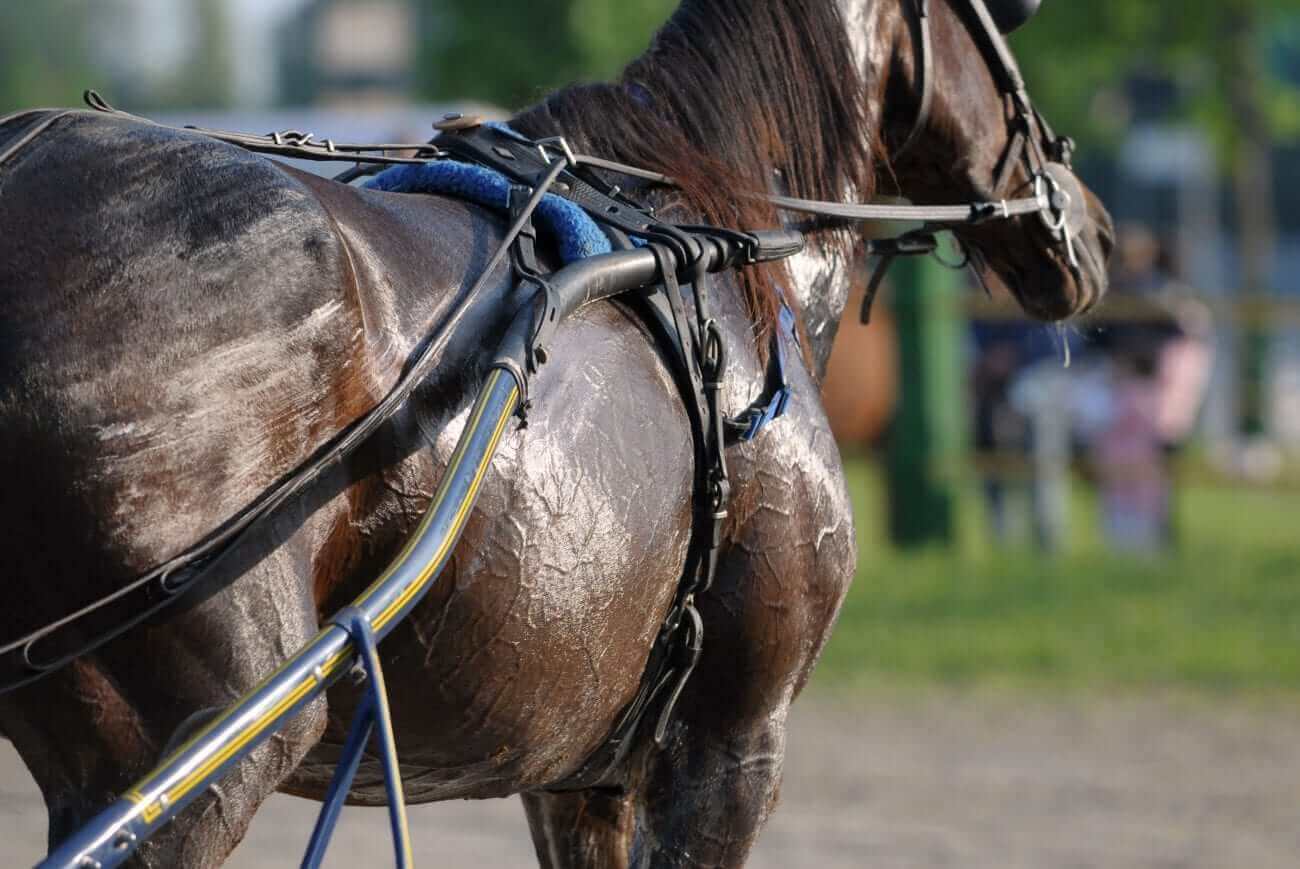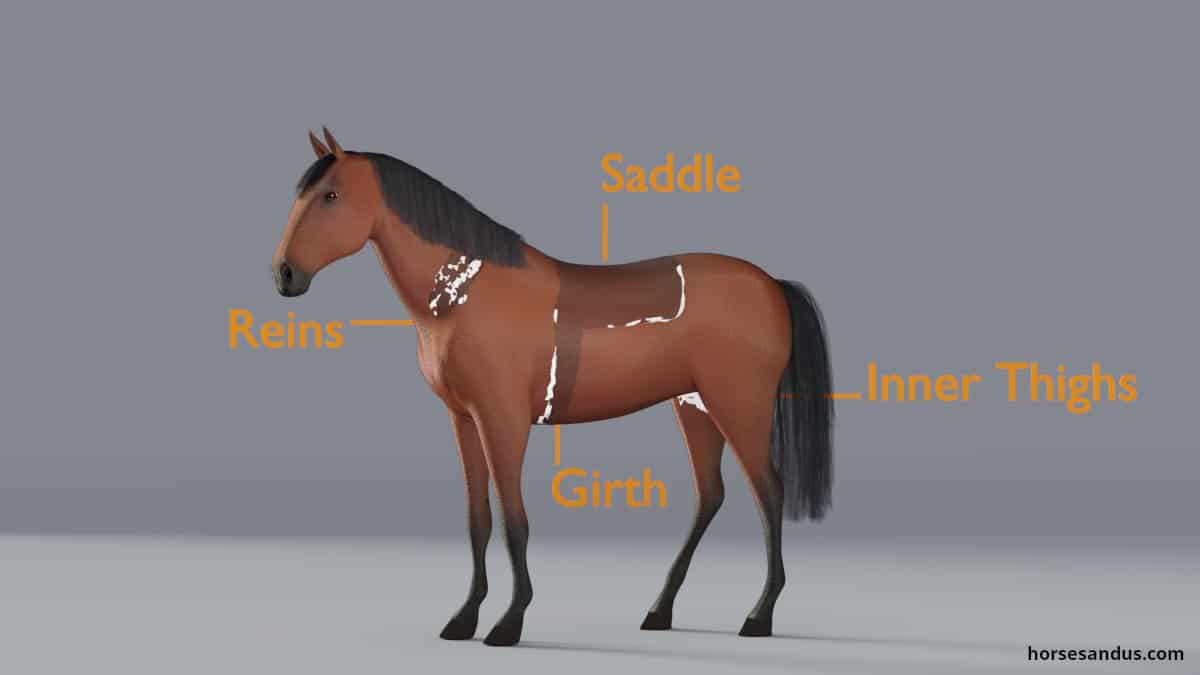Have you ever noticed that when horses exert themselves, their sweat often appears as a foamy, white substance? This distinctive feature of equine perspiration has puzzled many horse owners and enthusiasts. In this blog post, we delve into the reasons behind this phenomenon and what it means for the health and care of these magnificent animals.
- Horse sweat turns white and foamy due mainly to a protein called latherin. Latherin creates a detergent-like foam that aids in cooling the horse more efficiently during stress or over-exertion.
- The white, foamy sweat is rich in electrolytes, indicating that horses should always have access to fresh water to replenish these vital nutrients.
- While foamy sweat is a sign of exertion and the horse’s cooling system at work, excessive white foam can indicate overworking, especially in intense heat.
Insights into Equine Perspiration

Grasping the complexities of equine perspiration is essential for those involved in horse care and management. It’s a multifaceted process that reflects the animal’s exertion level and plays a crucial role in their well-being. Insights from horse exercise physiology help us comprehend how these creatures handle physical stress and adapt to their surroundings.
Thermoregulatory Role of Sweat in Horses
As horses engage in physical activities, their body temperature can climb, triggering sweat production. This response is essential for preventing overheating, which can pose significant health risks.
Exercise and Sweat Production in Horses
Exercising horses experience an intricate interplay between muscle activity and thermoregulation:
- The increase in muscular work leads to a higher internal temperature.
- Activation of sweat glands produces fluid that coats the skin.
- Evaporation of this fluid cools the body, moderating the temperature.
Broader Implications of Sweating for Horses
Horse sweat also assists in removing certain byproducts from the system, aiding in maintaining metabolic equilibrium. Observing a horse’s sweating can provide insights into the intensity of its activities and overall health.
Distinguishing Features of Horse Sweat
Although sweating is common across many mammals, horses exhibit specific traits:
- Equine sweat glands are notably active and cover a larger skin area, which is crucial for the thermoregulation of such large, active animals.
- The sweat contains a unique mixture of substances that not only cool but also help in maintaining a healthy coat and skin.
These characteristics emphasize the significance of understanding horse sweat for proper equine health management. It’s vital for horse caretakers to recognize the various aspects of this physiological process to keep their horses in top condition.
Optimizing the Care of Sweating Horses
Effective management of equine sweating entails careful observation and appropriate care strategies. It’s important to gauge sweat quantity and texture as these factors can signal the horse’s hydration levels and the appropriateness of their workload. Strategies for optimal horse perspiration management include:
- Regularly assessing the horse’s perspiration during various stages of activity.
- Ensuring access to water and potentially electrolyte replenishment to maintain fluid balance.
- Modifying exercise routines in response to environmental conditions to mitigate the risk of heat stress.
Integrating a thorough grasp of horse exercise physiology with an awareness of sweat-related factors can greatly benefit equine health and performance. Such knowledge empowers horse owners to create an environment where their equine partners can excel.
Unraveling the Mystery: Equine Sweat and Latherin’s Role

The sight of white foam on a horse’s body when it’s active is a telltale sign of its hard work and the unique ways in which these animals manage their body temperature. This phenomenon is rooted in the biochemistry of equine sweat, particularly the presence of a special protein called latherin. Appreciating the function of latherin not only captivates those who care for horses but is also integral to ensuring their well-being during and after physical activities.
How Latherin Enhances Cooling Efficiency
Latherin’s role in horses goes beyond just creating foam. It is crucial for regulating body temperature during exertion. By breaking down water’s surface tension, latherin allows sweat to spread and evaporate more effectively, thereby cooling the horse’s body more efficiently. This mechanism is particularly important for horses due to their large muscle mass and thick fur, which can trap heat.
Minerals in Motion: Electrolytes and Latherin
The presence of electrolytes in the white foam that forms on a horse’s coat serves more than a visual cue; it’s indicative of the complex interplay between these minerals and latherin in maintaining equine health. Electrolytes are not only responsible for the foamy appearance but also support critical physiological functions, such as nerve signaling and muscle contractions, which are vital during intense activity.
Complementary Actions of Salts and Proteins
The synergy between salts and proteins in equine sweat facilitates an effective cooling system. Salts replenish minerals lost during exercise, while proteins like latherin maximize the evaporative process crucial for temperature regulation. This balanced combination helps horses maintain their performance even in challenging conditions.
Equine Sweat: A Complex Blend
The composition of horse sweat is unique and serves multiple functions beyond cooling. It comprises a diverse mixture of proteins, lipids, and other substances that contribute to the health of the horse’s skin and coat. This rich biochemical cocktail is essential for the overall maintenance of equine health, especially during periods of high physical demand.
Influences on Equine Sweat Characteristics
Various environmental elements can alter the makeup of horse sweat, including temperature, air moisture levels, and the intensity of exertion. These changes can affect the amount and properties of latherin and electrolytes released, which in turn can influence the form and quantity of white foam observed on the horse’s body.
Leveraging Sweat Analysis for Horse Care
Discerning the reasons behind the white foam produced by horses is not merely academic — it has real-world applications in managing the health and athletic prowess of these animals. By tracking changes in the sweat’s appearance, caretakers can gauge a horse’s level of effort and need for hydration. Understanding the workings of latherin and electrolytes in regulating body temperature can also lead to the development of enhanced cooling methods and dietary supplements for horses performing strenuous tasks.
Exploring the Specifics of Equine Sweat

Delving deeper into the specifics of equine sweat, it’s important to consider the variety of influences that could affect its appearance and composition. A comprehensive understanding of these factors can greatly enhance the welfare of horses, particularly under strenuous conditions that could lead to more pronounced sweating.
Delving into the Triggers of Equine Sweat
White, foamy sweat in horses can result from a range of stimuli. Understanding these triggers helps in effectively managing and caring for these animals.
- Heat from Metabolism: A natural increase in body temperature through exercise can prompt the sweat glands to produce moisture to cool down.
- Emotional Reactions: Horses, like humans, may experience an increase in sweat production in response to psychological stress.
The Influence of External Conditions on Horse Sweat
External conditions can significantly alter both the volume and nature of sweat that horses produce.
- Weather and Climate: Elevated temperatures and high humidity can lead to horses sweating more in an attempt to regulate their body heat.
- Demanding Activities: High-intensity activities can push a horse’s physiological systems, increasing sweat output.
Identifying Normal and Unusual Sweat Patterns
Differentiating between typical sweating and potential signs of health concerns is key to preemptively addressing any issues.
- Typical Sweating Patterns: A reasonable amount of white froth is expected, especially in areas under physical pressure, such as under tack.
- Uncommon Sweat Production: An abundance of foam with little to no provocation may be an alert to potential health complications.
Evaluating Nutrition and Water Intake
Both diet and hydration levels can have a profound effect on the sweat’s properties, influencing its effectiveness in cooling the body.
- Importance of Nutrients: Essential vitamins and minerals are crucial for proper thermoregulation and sweat production.
- Significance of Water: Adequate hydration is necessary for normal sweat function, while a lack thereof can lead to a denser, more salient sweat.
The Role of Horse Grooming in Sweat Management
Regular grooming and maintaining skin health are important in ensuring that sweat performs its cooling function effectively.
- Cleanliness: Regular grooming is essential for removing debris that can interfere with sweat evaporation.
- Skin Condition: A healthy epidermis is better equipped for efficient sweating and temperature control.
Health Issues and Their Effect on Sweating
Aberrant sweating can be an indication of underlying health issues that may require veterinary intervention.
- Hormonal Imbalances: Disorders like Cushing’s disease can alter normal sweating responses.
- Breathing Difficulties: Respiratory challenges can lead to increased sweat due to the extra exertion needed for respiration.
Mindful observation of these factors can enable caretakers to more accurately assess and manage their horses’ sweat patterns, fostering optimal health conditions and performance capabilities.
Assessing Health Through Equine Perspiration

For those caring for horses, it’s imperative to be vigilant about the signs of potential health issues as indicated by changes in perspiration. Recognizing these signs is essential for the timely intervention and management of any problems that may arise from a horse’s natural cooling mechanism.
Indicators of Heat-Related Concerns
Heat-related issues in horses can present through several symptoms that require prompt attention:
- Unusually fast breathing or panting
- Elevated pulse
- General weakness or sluggishness
- Reduced urinary frequency
- Dryness in the mouth area
- Signs of depression or indifference
Dehydration, a related concern, might also be evidenced by:
- Recessed eyes
- Slow blood return in capillaries
- Reduced skin pliability
Being able to quickly identify and respond to these signs by providing water, shade, or veterinary assistance is crucial for horse caregivers.
Understanding Health Concerns Linked to White Foam
While white lather can be a normal part of a horse’s sweating process, certain health issues may be suggested by abnormal sweat patterns:
- Anhidrotic conditions: Characterized by insufficient sweat, leading to potential overheating.
- Signs of mineral imbalances: These may manifest as general fatigue, involuntary muscle movements, or digestive disturbances.
- Signs of pushing beyond physical limits: Notably, an overabundance of white froth, particularly in horses that are not in peak condition.
By observing the amount and characteristics of sweat, one can help pinpoint health concerns that may necessitate further action.
Addressing Anhidrotic Conditions
Inability to sweat, known as anhidrosis, poses a significant risk of overheating and can be identified by:
- Limited perspiration and flared breathing
- Elevated body temperature even with mild exercise
- Skin that feels dry and overly warm to the touch
It is imperative to cool down horses showing these symptoms and seek veterinary guidance for managing the condition.
Managing Mineral Losses
Mineral deficits due to sweating can have adverse effects, potentially leading to:
- A noticeable lack of energy
- Muscular tension or twitches
- Cardiac irregularities
Providing a balanced diet with adequate electrolytes can help prevent such issues from arising.
Preventing Excessive Physical Stress
Careful monitoring of a horse’s exertion levels is key to avoiding excessive physical stress, with symptoms to watch for including:
- Heavy sweating characterized by thick white foam
- Persistent rapid breathing beyond rest periods
- Aversion to movement or exercise
Modifying the intensity and frequency of exercise routines can help safeguard against overexertion.
Responding to Continuous White Foam
If white foam persists on a horse after physical activity, it may suggest inadequate recovery and could potentially cause skin discomfort or even infection if not dealt with through proper grooming and cooldown procedures.
By meticulously monitoring the nuances of horse perspiration, caretakers can make well-informed decisions regarding their horse’s healthcare and activity schedules, promoting not only their well-being but also enhancing their performance and longevity.
Proactive Care for Horses: A Focus on Hydration and Cooling

Maintaining a horse’s comfort and health, particularly during times of increased activity which leads to heightened perspiration, is an integral aspect of equine care. Horse owners and caretakers can adopt a proactive approach that emphasizes adequate hydration, balanced nutrition, and regulated exercise practices to ensure their horses cope well with the physical demands placed upon them.
Ensuring Proper Hydration Amidst Physical Activity
Constant access to clean water is essential for horses, especially when they lose significant fluids through sweat. Monitoring a horse’s water consumption is a crucial aspect of their care. During events such as endurance rides or competitions when normal water consumption may be insufficient, the use of electrolyte supplements can be beneficial in maintaining the horse’s mineral balance. Selecting the appropriate type of supplement, whether in paste or powder form, should be based on the horse’s particular requirements and activity levels.
- Emphasize the importance of constant water availability
- Keep a close watch on the horse’s drinking habits
- Employ electrolyte supplements judiciously to aid in mineral replenishment
Adjusting Exercise Routines to Support Thermal Balance
Organizing exercise schedules to avoid peak heat periods, such as the early morning or late evening, can help prevent thermal stress. Creating a workout regimen that includes regular breaks and shaded paths will also assist in managing a horse’s body temperature. Adjustments to the intensity and length of workouts may be necessary in response to extreme weather, thereby averting the risks associated with excessive sweating and its potential health implications.
- Plan exercise during less intense heat
- Include intervals for rest and seek shade when available during training
- Adapt exercise intensity to suit current weather conditions
Employing Cooling Techniques and Equipment
Post-exercise, the utilization of cooling equipment like specialized blankets and fans can aid in reducing a horse’s body temperature. These tools enhance the body’s natural evaporative cooling mechanism. Apparel designed for equine cooling is crafted from materials that retain moisture to extend the cooling effect, which is beneficial after vigorous exercise.
- Consider using cooling blankets or vests to assist with post-exercise temperature regulation
- Install fans to improve stable ventilation
- Select apparel that prolongs the effects of evaporative cooling
Nutritional Adjustments for Enhanced Heat Dissipation
A well-balanced diet is crucial for a horse’s thermoregulatory abilities. Nutrient-rich feed that includes sufficient vitamins and minerals supports the sweating mechanism and aids recovery. In cases of significant sweat loss, increasing the availability of minerals such as sodium, potassium, and magnesium in the diet is recommended. Collaboration with an equine nutrition expert can result in a diet that meets the specific needs of each horse, ensuring their physiological systems are well-supported for heat dispersal.
- Ensure a nutrient-rich diet for thermoregulatory support
- Modify mineral content in the diet according to sweat loss
- Consult with a nutritionist for a tailored feeding regimen
Identifying and Addressing Anhidrosis in Horses
Anhidrosis, a condition marked by reduced sweat production, can have serious repercussions for a horse’s health in warm conditions. Early detection of anhidrosis is imperative to prevent heat-related illnesses. If a horse demonstrates anhidrosis symptoms like minimal sweating, difficulty breathing, or high body temperature with minimal exertion, immediate cooling methods should be employed. This may involve moving the horse into shaded areas, promoting better ventilation, and applying water for external cooling. Managing anhidrosis over the long term may include environmental and dietary adjustments, as well as modifications to exercise routines.
- Stay alert for any signs of compromised sweating ability
- Quickly cool horses showing symptoms of anhidrosis
- Adopt long-term care strategies for horses with anhidrosis
Through diligent management that includes hydration monitoring, dietary support, controlled exercise, and cooling techniques, horse owners and caretakers can effectively maintain their horse’s health and performance capabilities, particularly in situations that may induce robust sweating.
Enhancing Recovery After Workouts: The Importance of Post-Exercise Equine Care

Subsequent to a training session, horses may exhibit white, frothy sweat, signaling the need for a meticulous post-exercise regimen to support their recovery and avert potential dermatological issues. This section will explore effective strategies for post-workout equine care, emphasizing the necessity of both a gradual cool-down and thorough grooming to ensure the horse’s comfort and skin integrity.
Strategies for a Gradual Cool-Down of Horses
Implementing a progressive cool-down phase following physical exertion is crucial for equine recovery. This period helps stabilize the horse’s core temperature and permits a reduction in heart rate. It is recommended to walk the horse on a loose rein for a duration of 15 to 20 minutes after vigorous activities, promoting blood circulation to the muscles and reducing the possibility of lactic acid accumulation, which can cause muscle stiffness and discomfort.
- Commence with a leisurely walk to foster a calm disposition.
- Diminish the exercise intensity incrementally before bringing the workout to a halt.
- Use this opportunity to monitor the horse’s physical and mental state for any indications of strain or abnormality.
Effective Grooming Techniques for Post-Workout Care
Cleaning the horse after exertion is vital to remove sweat residues and prevent skin complications. A prompt grooming session using appropriate tools like a cactus cloth or a sponge with water can effectively eliminate sweat and foam build-up. This step is particularly critical to prevent the drying and potential irritation caused by the salts and proteins from the sweat.
- Employ gentle, circular strokes to cleanse the horse’s coat.
- If circumstances permit, rinse the horse with cool water, focusing on areas with a higher concentration of foam.
- After the wash, use a sweat scraper to remove surplus water, which can expedite the drying process.
Post-Exercise Considerations for Enhancing Equine Well-Being
Additional actions can be taken post-exercise to promote the horse’s health. Providing a well-aerated environment for the horse to rest in, along with the option of a leisurely walk in a shaded area, can further assist in the cooling process. Ensuring that the stable or resting quarters have adequate airflow is essential for facilitating natural body temperature reduction.
- Arrange for a serene, shaded area where the horse can unwind after the training session.
- Maintain sufficient air circulation in the stable to assist in body heat dissipation.
- Stay vigilant for any signs of delayed stress or unease in the horse.
Incorporating these practices into a post-workout routine significantly contributes to the horse’s recovery and overall health, preparing them for future activities. Close observation of the horse’s post-exercise behavior is an insightful tool in assessing their well-being and recuperation.
If you’re curious about different aspects of equine life and traits, you might find our articles intriguing. For instance, you can explore the unique hues of horses by reading about what color a sorrel horse is. If you’re interested in horse care and maintenance, understanding why farriers hot-shoe a horse could provide valuable insights. Additionally, the topic of why horse meat is illegal in many places is a complex issue that touches on ethics, culture, and legislation. Dive into these articles to expand your knowledge on these fascinating subjects!
FAQs: Common Questions About Horse Sweat
Horse sweat white is a fascinating topic that raises many questions. Here, we’ve addressed some of the basics, but don’t hesitate to consult with a veterinarian or equine expert for more in-depth information and personalized advice for your horse’s needs.



